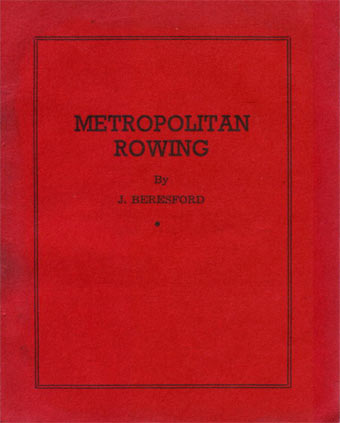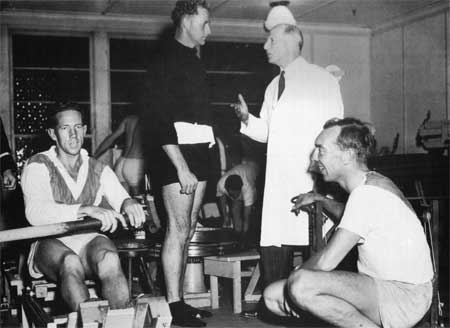History of Leichhardt Rowing Club
On these Bright Waters - A Centennial History of Leichhardt Rowing Club 1886-1986
Reproduced with permission of the author Merle Kavanagh
Table of Contents
Chapters
- The beginning
- Opening ceremony of club premises
- Early years
- 19th century social events
- Loss of the club's first shed
- Into the 20th century
- The social scene before the war
- The first world war
- Between the world wars
- The 2nd world war
- The winning years after WWII
- The struggles of the sixties and seventies
- The last decade
- Some rowing highlights
- Junior oarsmen
- Women
- Oarmanship
- Regattas and the fleet
- Some accidents and incidents
- Old boys/reunions
Appendices
- Some club personalities
- Honorary life members
- Trophies awarded
- Roll of office bearers
- Coaches and Coxswains
- Current Committee and members 1985-86
- Members of Leichhardt Old Oarsmen's Union
- NSWRA International representatives
- NSWRA Interstate representatives
- Successes in NSWRA Championships
- NSWRA Ladies Championships
- Boat race officials
- Members who served as NSWRA office bearers
17. Oarsmanship
One of the first pamphlets published by the N.S.W. Rowing Association was called "Instructions in the Elements of Oarsmanship", which appeared in the first decade of this century. It set out instructions in the elements of oarsmanship, described the style of rowing as adopted by the N.S.W. Rowing Assn. and gave advice on handling and launching boats. For launching boats the booklet suggested "Care should be taken that the feet are so placed that the toes do not project beyond the edge of the pontoon". When embarking, rowers were advised to "Remove the boot from the foot nearest the boat" and later, when gingerly settled, to replace the boot but "avoid touching the skin of the boat with toe or heel, as it is very easily split" which many oarsmen know to their dismay.
In 1925 they issued a "Style of Rowing" booklet for 1/-d. which featured a number of photographs illustrating the correct stroke and headed pages with "Be in Condition - it pays!" or "Your legs are your strongest muscles - use them". It included a detailed section on How to Row - How to Coach, and described the revised style of rowing adopted in 1924.
They later published a booklet "Metropolitan Rowing" by Mr. Julius (Jack) Beresford, coach of England's 1938 Empire Games crew. The club read, marked and inwardly digested these guides, making efforts to streamline their strokes, the coaches over the years combining exercise on land and on the water for maximum results. In 1933/34 a Mr. Thompson donated a rowing machine.

Metropolitan Rowing
In the late thirties discussion on rowing style took place, sometimes becoming a little heated, and continued into the forties. A special committee meeting was held on 22nd September 1941 when the new style for the Catch and the Recovery was proposed.
Again in July 1943 the committee discussed style and agreed that the coaches, G. Davies and L. 0'Donnell, be authorised to coach for an unlimited trial period to be defined by the Captain; also that the style (modified Haberfield Rowing Club style, rowed whilst Leichhardt was at Haberfield during the rebuilding of their shed) they outlined be unanimously adopted by all members whether training or otherwise.
During the 1949/50 season a group of club members, following the training methods of Professor F.S. Cotton of Sydney University, commenced training under the coaching of Lance Robinson, a very successful Haberfield oarsman and ex-Leichhardt member, with the view of representing Australia at the Empire Games. This ambition was not achieved as they were narrowly beaten by an experienced Haberfield crew in a test race at Ballarat, but they left an impression on N.S.W. Rowing which would be remembered for years to come.
The club continued to follow these principles whenever possible and the 1955 Annual Report records "Leichhardt Rowing Club was formed and carried on for almost 60 years with ups and downs until Professor Frank Cotton and his 'machines' arrived. Then came Leichhardt to the fore, took the risk inherent with any new venture, nearly crashed, but then battled back to the top. However, it was much easier to win races than have the machines accepted as a great adjunct to crew selection and the Prof's methods of training adopted as a basis in the major circles." The following year the death of Professor F.S. Cotton was recorded.

Professor Cotton with G Williamson, E Curtain and P Evatt
But machines had come to stay. The 1958/59 Annual Report records the win of the N.S.W. Eight in the King's Cup (the first win since 1951) with a mainly Leichhardt crew trained by Leichhardt coaches on Leichhardt methods, which were the principles laid down by Prof. Cotton. A pair of new Ergometers were acquired during the year and were a vast improvement on the originals, thanks to J. Harrison and E. Curtain.
By 1969 the Reports were recording "The machines themselves have received wide acclaim in both the United States and England and Ted (Curtain) has had interested enquirers from both countries. We are proud to inform our members that wherever a machine of this type will be found overseas it is known as the Leichhardt Machine. Professor Cotton would have been extremely happy to see his efforts so widely acclaimed in this present day and age." The machines continued to be an asset to the club.
